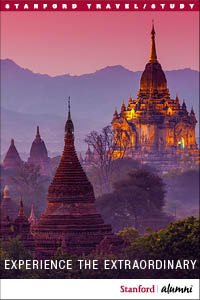President's Column
Nourishing the Arts in All Forms
From Wallace Stegner to cell phone ‘concerts,’ a tradition of imagination.
Photo: Glenn Matsumura
By John Hennessy
This year marks the centennial of Wallace Stegner’s birth, and I am reminded of his great influence—as a writer and teacher, as well as an advocate and expositor for the American West. Author of more than two dozen books, recipient of the Pulitzer Prize and the National Book Award, Stegner shaped generations of writers and conservationists through his work.
He also had a profound influence on Stanford. After joining the faculty in 1945, he established the creative writing program. It has become one of the most distinguished programs in the country, attracting writers such as Larry McMurtry, Tillie Olsen, Wendell Berry, Robert Pinsky and Robert Hass over the years. Today the Stanford creative writing program offers courses to students throughout the University. Through the Wallace Stegner Fellowships, it gives the next generation of notable poets and fiction writers opportunities to focus on their craft.
In his last letter to David Starr Jordan, Leland Stanford wrote: “The imagination needs to be cultivated and developed to assure success in life.” Certainly, imagination and creativity will be critical to address the challenges of this century, and the arts are integral to their development. The arts also help us deal with complexity, ambiguity and diversity, key characteristics of our globalized society.
Jane Stanford also appreciated the arts. In 1902, nine years after Leland’s death, Jane described a museum as “necessary and appropriate to a university of high degree.” But after the 1906 earthquake, more than half of the museum was destroyed and much of the collection lost. By the early 1960s, parts of the museum basement (where artworks are stored today) were used to hold biological specimens, and the art department was crowded into a small building with insufficient classroom or studio space.
In 1963 the arts at Stanford were reinvigorated when Professor Lorenz Eitner arrived on campus to become chair of the art department and director of the museum. Eitner, who passed away in March, helped get a new building for the art department and began the renovation and expansion of the museum. He also recruited Albert Elsen, who played a central role in acquiring our Rodin collection. Two months after Eitner retired in 1989, damage from the Loma Prieta earthquake closed the museum again.
In 1999, rebuilt and significantly expanded, the museum reopened as the Iris and B. Gerald Cantor Center for Visual Arts. Many of our alumni and friends have been generous in sharing their collections, and throughout the year, we have celebrated their passion for art and collecting with a series of exhibitions. A current show, “Pop to Present,” features works from the past half-century.
The arts often cross disciplinary boundaries, and when we launched an arts initiative as part of The Stanford Challenge, one area of focus was on the arts, sciences and technologies. A new major, film and media studies, in the department of art and art history has gained quite a following among undergraduates, and in 2006, a master of fine arts program in documentary film and video was established. And at the Hasso Plattner Institute of Design faculty and students from engineering disciplines and the arts focus on “design thinking,” looking at what makes devices both easy to use and aesthetically appealing.
Stanford’s Center for Computer Research in Music and Acoustics (CCRMA) explores how devices such as laptops and cell phones can be used as musical instruments. The Stanford Mobile Phone Orchestra capitalizes on the cell phone’s ubiquity and technological features to produce a mysterious music. As Ge Wang, assistant professor of music and founder of MoPhO, explained to the Stanford Report, cell phones are the latest “platforms for creativity.” Through his start-up SonicMule (Smule), Wang also has developed an iPhone application that transforms this 21st-century personal device into an ocarina, an ancient wind instrument dating back 12,000 years.
Writing in Where the Bluebird Sings to the Lemonade Springs, Wallace Stegner reflected on the work of the next generation of writers and proclaimed, “I feel the surge of the inextinguishable western hope.” Today that surge of hope is felt throughout Stanford in concerts performed on iPhones, in the documentaries of tomorrow’s filmmakers, in collections shared at the Cantor, in the words of our newest Stegner Fellows and in the planning for the new Helen and Peter Bing Concert Hall. Through these and other programs, Stanford celebrates the arts as necessary treasures—stimulating innovation and discovery; providing insight into traditions, cultures and times beyond our own; offering respite from the difficulties of the day; and prompting deeper reflection on the human experience.
Actions
-
Let Me Introduce Myself
September/October 2008 -
The Menace Within
July/August 2011 -
The Persecution of Daniel Lee
July/August 2011 -
What It Takes
November/December 2013 -
The Effort Effect
March/April 2007








Comments (0)